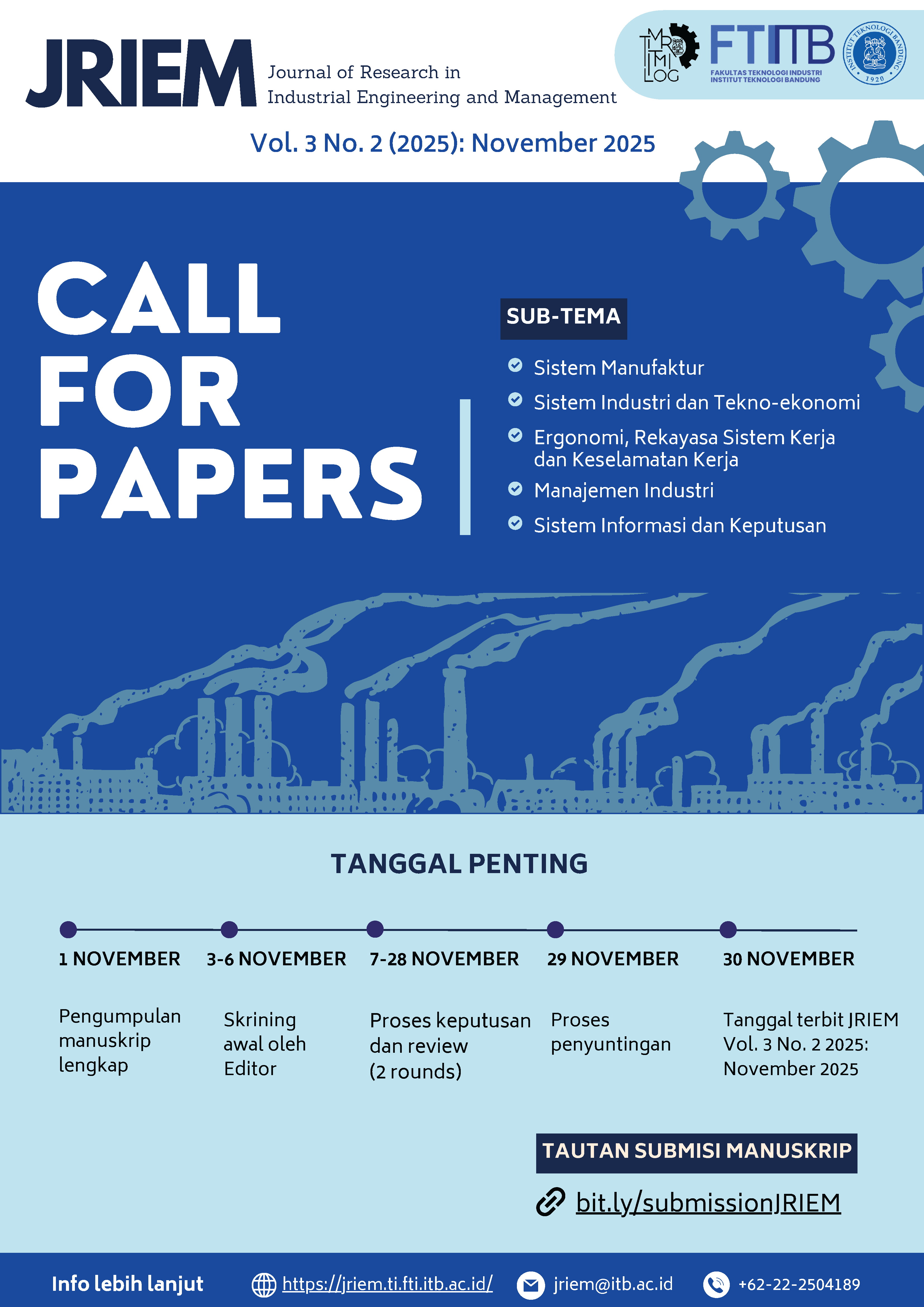Evaluasi Risiko yang Harus Dihadapi Vendor dalam Memenuhi Kebutuhan Permintaan Produk Perishable Bencana Gunung Api Menggunakan Simulasi Monte Carlo
DOI:
https://doi.org/10.61221/jriem.v2i2.42Kata Kunci:
simulasi monte carlo, bencana gunung api, bantuan bencana, produk perishableAbstrak
Sebagai negara yang masuk ke dalam Kawasan ring of fire atau Kawasan cicin api, Indonesia memiliki banyak Gunung Api. Dari sekian banyaknya gunung api yang masih aktif tersebut, sekitar 40% gunung api tidak terpantau dengan baik. Hal ini menjadikan Indonesia menjadi salah satu negara dengan ancaman bencana gunung api yang cukup tinggi. Salah satu tantangan dalam manajemen bencana adalah pada pengelolaan logistik khususnya bantuan bencana berupa bahan makanan yang memiliki masa kedaluwarsa (bersifat perishable) untuk memenuhi kebutuhan korban terdampak. Penanganan logistik jenis ini harus memastikan bahwa produk yang digunakan tidak ada yang kedaluwarsa. Salah satu penanganan adalah dengan memberikan wewenang pengelolaan kepada pihak ketiga, khususnya vendor yang juga menangani permintaan harian. Hal ini dimaksudkan agar produk perishable dapat dikelola dengan cara diputar untuk memenuhi semua permintaan selama vendor tetap memperhatikan jumlah persediaan yang ada di gudang. Penelitian ini bertujuan untuk mengevaluasi risiko yang harus dihadapi jika sebuah vendor menerapkan kerja sama tersebut. Evaluasi dilakukan dengan simulasi monte carlo untuk menentukan skenario mana yang terbaik yang bisa dipilih oleh vendor. Hasil analisis menunjukkan bahwa penerapan skenario 2 yaitu menerapkan asumsi bahwa bencana mungkin akan terjadi satu kali di sepanjang periode perencanaan merupakan skenario terbaik bagi vendor.
Referensi
Andreastuti, S., Paripurno, E. T., Gunawan, H., Budianto, A., Syahbana, D., & Pallister, J. (2019). Character of Community Response to Volcanic Crisis at Sinabung and Kelud Volcanoes. Journal of Volcanology and Geothermal Research, 298-310.
Balcik, B., Bozkir, C. D., & Kundakcioglu, O. (2016). A Literature Review on Inventory Management in Humanitarian Supply Chain. Surveys in Operations Research and Management Science, 101 - 116.
Banomyong, R., & Sopadang, A. (2010). Using Monte Carlo Simulation to refine emergency logistics response model: a case study. International Journal of Physical Distribution & Logistics Management, 709-721.
BNPB. (2013). Tanggap Darurat 72 Jam Pertama Masa Krusial Penyelamatan Masyarakat Terdampak. Diambil kembali dari Badan Nasional Penanggulangan Bencana: https://www.bnpb.go.id/berita/tanggap-darurat-72-jam-pertama-masa-krusial-penyelamatan-masyarakat-terdampak
Daud, M. S., Hussein, M. Z., Nasir, M. E., Abdullah, R., Kassim, R., Suliman, M. S., & Saludin, M. R. (2016). Humanitarian Logistics and Its Challenges: The Literature Review. International Journal of Supply Chain Management ,5(3), 107-110.
Dokumen Rencana Kontingensi Erupsi Gunung Api Merapi Adaptasi Terhadap Protokol Kesehatan Covid-19 Tahun 2021
ESDM. (2024). Tingkat Aktivitas Gunung api . Diambil kembali dari magma.esdm.go.id: https://magma.esdm.go.id/v1/gunung-api/tingkat-aktivitas
Hamdan, B., & Wang, P. (2019). Advanced Inventory Planning for Humanitarian and Disaster Relief Aids. IIE Annual Conference. Proceedings, Urbana: Institute of Industrial and System Engineerings (IISE), 742-747.
Moshtari, M., Altay, N., Heikkila, J., & Goncalves, P. (2021). Procurement in humanitarian organizations: Body of knowledge and practitioner’s challenges . International Journal of Production Economics, 233, 108017.
Oktarina, R., Bahagia, S. N., Diawati, L., & Pribadi, K. S. (2016). Identification of Minimum Standards in Emergency Goods for Earthquake Relief in Indonesia. Journal of Disaster Research, 545-551.
Peraturan Menteri Sosial Republik Indonesia Nomor 01 Tahun 2013 tentang Bantuan Sosial Bagi Korban Bencana;
Virkhansa, C. F., Setiawan, B. D., & Dewi, C. (2019). Klasifikasi Status Gunung Berapi dengan Metode Learning Vector Quantization (LVQ). Jurnal Pengembangan Teknologi Informasi dan Ilmu Komputer, 3(7) , 7119-7126.
Voyer, J., Dean, M., & Pickles, C. (2015). Understanding Humanitarian Supply Chain Logistics with System Dynamics Modeling. USM Digital Commons (hal. 1-18). Portland: University of Southern Maine.
Wassenhove, L. N., & Martinez, A. J. (2010). Using OR to Adapt Supply Chain Management Best Practices to Humanitarian Logistic. International Transactions In Operational Research, 307 - 322.
Weraikat, D., Zanjani, M. K., & Lehoux, N. (2019). Improving sustainability in a two-level pharmaceutical supply chain through Vendor-Managed Inventory System. Operations Research for Healt Care, 44-55.
Whybark, D. C. (2007). Issues in managing disaster relief inventories. International journal of production economics, 108(1-2), 228-235.
Unduhan
Diterbitkan
Cara Mengutip
Terbitan
Bagian
Lisensi
Hak Cipta (c) 2024 Ikhsan Prasetyo, Andi Cakravastia Arisaputra Raja

Artikel ini berlisensi Creative Commons Attribution 4.0 International License.




